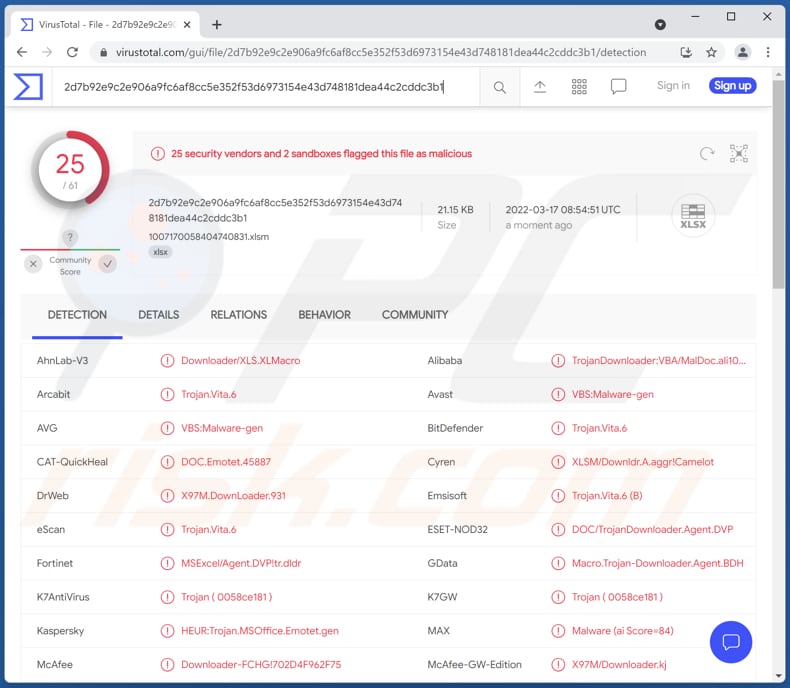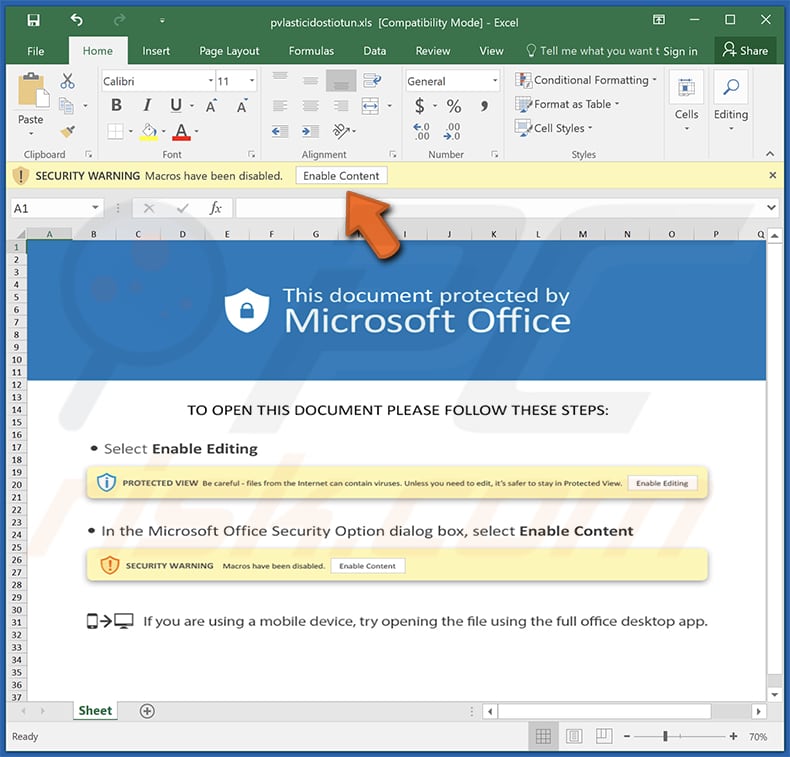How to remove DOC/TrojanDownloader.Agent Trojan
TrojanAlso Known As: DOC/TrojanDownloader.Agent malware
Get free scan and check if your device is infected.
Remove it nowTo use full-featured product, you have to purchase a license for Combo Cleaner. Seven days free trial available. Combo Cleaner is owned and operated by RCS LT, the parent company of PCRisk.com.
What is DOC/TrojanDownloader.Agent?
DOC/TrojanDownloader.Agent is a detection name for malicious Microsoft Office documents (for example, Word, Excel). The purpose of such documents is to infect computers with malware. Computers get infected once macros commands in these documents are enabled. Most cybercriminals disguise them as invoices, purchase orders, receipts, forms, or other documents.

More about DOC/TrojanDownloader.Agent
Once a malicious Microsoft Office document is opened, MS Office shows a security warning stating that Macros have been disabled (the document's active content is disabled). Macros automate common tasks in Microsoft Office documents. Although, it is common for this functionality to be used by cybercriminals as a tool to infect computers with malware.
Malicious documents infect computers after macros commands (content/editing) are enabled. Cybercriminals use such documents to distribute ransomware, cryptocurrency miners, keystroke loggers, and other malicious software. It is important to mention that MS Office versions released before 2010 do not have the "Protected View" mode, preventing computer infections while the document's content is disabled.
| Name | DOC/TrojanDownloader.Agent malware |
| Threat Type | Malicious MS Office document |
| Detection Names | Avast (VBS:Malware-gen), Combo Cleaner (Trojan.Vita.6), ESET-NOD32 (Multiple Detections), Kaspersky (HEUR:Trojan.MSOffice.Emotet.gen), Microsoft (TrojanDownloader:O97M/Emotet.PKCU!MTB), Full List (VirusTotal) |
| Payload | Different types of malware |
| Symptoms | Trojans are designed to stealthily infiltrate the victim's computer and remain silent, and thus no particular symptoms are clearly visible on an infected machine. |
| Distribution methods | Infected email attachments, social engineering, compromised social media, email, and other accounts |
| Damage | Stolen passwords and banking information, identity theft, the victim's computer added to a botnet. |
| Malware Removal (Windows) |
To eliminate possible malware infections, scan your computer with legitimate antivirus software. Our security researchers recommend using Combo Cleaner. Download Combo CleanerTo use full-featured product, you have to purchase a license for Combo Cleaner. 7 days free trial available. Combo Cleaner is owned and operated by RCS LT, the parent company of PCRisk.com. |
What harm can opening a malicious document cause?
Enabling content (macros commands) in opened malicious documents can cause data encryption, identity theft, monetary loss, and other problems. It depends on the type of malware injected into a document). Examples of malware that has been or is still being distributed through MS Office documents are Dridex, Emotet, NanoCore.
How malicious documents infect computers?
Malicious MS Office documents infect computers after enabling content (macros commands). Pretty often, those documents contain a message encouraging to enable content, but at the same time, the MS Office itself shows a security warning stating that content is disabled for security reasons. MS Office opens documents in "Protected View" mode when documents are downloaded from untrustworthy sources.
The most popular way to distribute malicious documents is to send them as email attachments. In other cases, these documents can be distributed using free file hosting sites, untrustworthy websites, compromised social media (or other) accounts.
How to avoid installation of malware?
Do not trust links and attachments in suspicious (irrelevant) emails sent from unknown addresses. Opening them will likely cause computer infections. Download files and programs from official pages. Avoid opening files downloaded from P2P networks, P2P networks, third-party downloaders, etc.
Use official tools or functions provided by the official developer to update and activate the installed software. Keep the operating system and installed programs up to date. Use reliable antivirus software for computer protection and run system scans with it regularly.
If you believe that your computer is already infected, we recommend running a scan with Combo Cleaner Antivirus for Windows to automatically eliminate infiltrated malware.
Example of a malicious document opened in the "Protected View" mode:

Instant automatic malware removal:
Manual threat removal might be a lengthy and complicated process that requires advanced IT skills. Combo Cleaner is a professional automatic malware removal tool that is recommended to get rid of malware. Download it by clicking the button below:
DOWNLOAD Combo CleanerBy downloading any software listed on this website you agree to our Privacy Policy and Terms of Use. To use full-featured product, you have to purchase a license for Combo Cleaner. 7 days free trial available. Combo Cleaner is owned and operated by RCS LT, the parent company of PCRisk.com.
Quick menu:
- What is DOC/TrojanDownloader.Agent?
- STEP 1. Manual removal of DOC/TrojanDownloader.Agent malware.
- STEP 2. Check if your computer is clean.
How to remove malware manually?
Manual malware removal is a complicated task - usually it is best to allow antivirus or anti-malware programs to do this automatically. To remove this malware we recommend using Combo Cleaner Antivirus for Windows.
If you wish to remove malware manually, the first step is to identify the name of the malware that you are trying to remove. Here is an example of a suspicious program running on a user's computer:

If you checked the list of programs running on your computer, for example, using task manager, and identified a program that looks suspicious, you should continue with these steps:
 Download a program called Autoruns. This program shows auto-start applications, Registry, and file system locations:
Download a program called Autoruns. This program shows auto-start applications, Registry, and file system locations:

 Restart your computer into Safe Mode:
Restart your computer into Safe Mode:
Windows XP and Windows 7 users: Start your computer in Safe Mode. Click Start, click Shut Down, click Restart, click OK. During your computer start process, press the F8 key on your keyboard multiple times until you see the Windows Advanced Option menu, and then select Safe Mode with Networking from the list.

Video showing how to start Windows 7 in "Safe Mode with Networking":
Windows 8 users: Start Windows 8 is Safe Mode with Networking - Go to Windows 8 Start Screen, type Advanced, in the search results select Settings. Click Advanced startup options, in the opened "General PC Settings" window, select Advanced startup.
Click the "Restart now" button. Your computer will now restart into the "Advanced Startup options menu". Click the "Troubleshoot" button, and then click the "Advanced options" button. In the advanced option screen, click "Startup settings".
Click the "Restart" button. Your PC will restart into the Startup Settings screen. Press F5 to boot in Safe Mode with Networking.

Video showing how to start Windows 8 in "Safe Mode with Networking":
Windows 10 users: Click the Windows logo and select the Power icon. In the opened menu click "Restart" while holding "Shift" button on your keyboard. In the "choose an option" window click on the "Troubleshoot", next select "Advanced options".
In the advanced options menu select "Startup Settings" and click on the "Restart" button. In the following window you should click the "F5" button on your keyboard. This will restart your operating system in safe mode with networking.

Video showing how to start Windows 10 in "Safe Mode with Networking":
 Extract the downloaded archive and run the Autoruns.exe file.
Extract the downloaded archive and run the Autoruns.exe file.

 In the Autoruns application, click "Options" at the top and uncheck "Hide Empty Locations" and "Hide Windows Entries" options. After this procedure, click the "Refresh" icon.
In the Autoruns application, click "Options" at the top and uncheck "Hide Empty Locations" and "Hide Windows Entries" options. After this procedure, click the "Refresh" icon.

 Check the list provided by the Autoruns application and locate the malware file that you want to eliminate.
Check the list provided by the Autoruns application and locate the malware file that you want to eliminate.
You should write down its full path and name. Note that some malware hides process names under legitimate Windows process names. At this stage, it is very important to avoid removing system files. After you locate the suspicious program you wish to remove, right click your mouse over its name and choose "Delete".

After removing the malware through the Autoruns application (this ensures that the malware will not run automatically on the next system startup), you should search for the malware name on your computer. Be sure to enable hidden files and folders before proceeding. If you find the filename of the malware, be sure to remove it.

Reboot your computer in normal mode. Following these steps should remove any malware from your computer. Note that manual threat removal requires advanced computer skills. If you do not have these skills, leave malware removal to antivirus and anti-malware programs.
These steps might not work with advanced malware infections. As always it is best to prevent infection than try to remove malware later. To keep your computer safe, install the latest operating system updates and use antivirus software. To be sure your computer is free of malware infections, we recommend scanning it with Combo Cleaner Antivirus for Windows.
Frequently Asked Questions (FAQ)
What are the biggest issues that malware can cause?
It depends on the type of malware. Cybercriminals can use it to encrypt files, steal identities, hijack online accounts, infect computers with additional malware, mine cryptocurrency using the infected device, and more.
What is the purpose of a malicious MS Office document?
Cybercriminals distribute malicious documents to trick users into opening them and enabling content (macros commands). Once macros are enabled, those documents infect computers with malware (for example, ransomware).
How malicious documents are distributed?
Most cybercriminals send these documents via email. They send emails containing malicious attachments. Typically, they disguise malicious documents as invoices, forms, purchase orders, etc. Also, malicious documents are distributed using free file hosting sites, social media (or other) platforms.
Will Combo Cleaner protect me from malware?
Yes, Combo Cleaner can detect and eliminate almost all known malware infections. If your computer is infected with high-end malware, a full system scan is necessary. Quick scan is not enough to find malware (usually high-end malware) hidden deep in the operating system.
Share:

Tomas Meskauskas
Expert security researcher, professional malware analyst
I am passionate about computer security and technology. I have an experience of over 10 years working in various companies related to computer technical issue solving and Internet security. I have been working as an author and editor for pcrisk.com since 2010. Follow me on Twitter and LinkedIn to stay informed about the latest online security threats.
PCrisk security portal is brought by a company RCS LT.
Joined forces of security researchers help educate computer users about the latest online security threats. More information about the company RCS LT.
Our malware removal guides are free. However, if you want to support us you can send us a donation.
DonatePCrisk security portal is brought by a company RCS LT.
Joined forces of security researchers help educate computer users about the latest online security threats. More information about the company RCS LT.
Our malware removal guides are free. However, if you want to support us you can send us a donation.
Donate
▼ Show Discussion